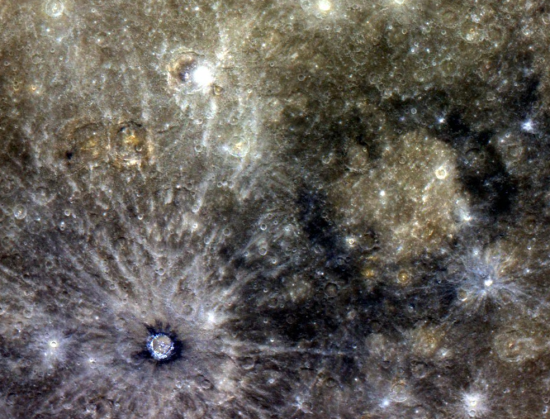In color from Mercury
The Messenger spacecraft has now been in orbit around Mercury since the end of March, almost four months. During that time the probe has sent back many fascinating images, showcasing a hot, alien planet whose surface was formed by impacts, volcanic activity, and some processes that no one as yet understands.
Most of the released images, however, have been in black and white, which at first glance makes one think that Mercury is not unlike the Moon. This week the Messenger team released a color image, demonstrated clearly how false this assumption is. The image below shows two very different craters, a dark-haloed crater named Basho at the bottom left of the image, and a very bright crater, Kalidasa crater, near the top left. On the right of the image is a dark haloed Tolstoj basin. For an uncropped full resolution version go here.

The bright features on the floor of Kalidasa crater as well as the inner rim of Basho crater are very different than anything seen on the moon. Closeup images have shown these bright patches “to be clusters of rimless, irregular pits varying in size from hundreds of meters to several kilometers. These pits are often surrounded by diffuse halos of higher-reflectance material, and they are found associated with central peaks, peak rings, and rims of craters.” These geological features, which appear to be relatively young, are not seen on the moon, and scientists don’t yet understand what causes them.
Similar, the scientists remain somewhat puzzled over the dark halos they have found around many craters.
The colors — blacks, whites, browns, tans, and even goldish orange — illustrate how different Mercury is from the moon. Color images of the moon never show this much variety. I expect future research will tell us that Mercury had a far more complicated geological history than the moon. Unfortunately, I expect that this future research will probably require a spacecraft to land on the planet, something that is at least two decades away considering the present budget realities.
On Christmas Eve 1968 three Americans became the first humans to visit another world. What they did to celebrate was unexpected and profound, and will be remembered throughout all human history. Genesis: the Story of Apollo 8, Robert Zimmerman's classic history of humanity's first journey to another world, tells that story, and it is now available as both an ebook and an audiobook, both with a foreword by Valerie Anders and a new introduction by Robert Zimmerman.
The print edition can be purchased at Amazon or from any other book seller. If you want an autographed copy the price is $60 for the hardback and $45 for the paperback, plus $8 shipping for each. Go here for purchasing details. The ebook is available everywhere for $5.99 (before discount) at amazon, or direct from my ebook publisher, ebookit. If you buy it from ebookit you don't support the big tech companies and the author gets a bigger cut much sooner.
The audiobook is also available at all these vendors, and is also free with a 30-day trial membership to Audible.
"Not simply about one mission, [Genesis] is also the history of America's quest for the moon... Zimmerman has done a masterful job of tying disparate events together into a solid account of one of America's greatest human triumphs."--San Antonio Express-News


this is so mindblowing , yes people assume mercury is like the moon in general . when I have a picture of mercury on my desktop people always thought it was the moon , but to anyone who likes space stuff it is easy to tell the difference in b&w . the fact that the surface features are so unique and close together is very interesting . <3 messenger!